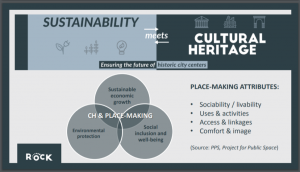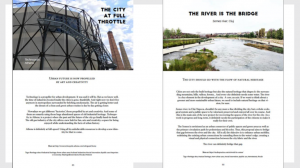In June 2019, ROCK project has been part of the European Placemaking week in Valencia (https://lamarinalivinglab.com/placemakingweekeurope2019/), with a dedicated workshop entitled Heritage building stronger communities. Throughout the session, we emphasized the instrumental value of cultural heritage as a placemaking tool in different urban settings, focused on four main aspects:
- Sociability and liveability of a place (through participatory approaches for social inclusion);
- Vibrant uses & activities (experimented through sustainable adaptive reuse of CH);
- Increased Accessibility & linkages (exploring both physical/ non-physical accessibility of CH) and
- Comfort & image (connected with safety, security, but also branding and CH promotion).
Since ROCK cities assume that cultural heritage is used as a tool to experiment with collaborative models of urban development, the mixture between placemaking approaches and cultural heritage is a great way to create a sense of place for communities to enjoy, preserve and take ownership of cultural heritage in their neighbourhoods. As such, reusing and adapting the cultural heritage with the help of a community strengthens the sense of belonging by positively linking the city’s past to its future, and offering robust infrastructure to the needs of citizens. The basic principles of placemaking can be applied to historic areas and buildings, and the three Replicator Cities from ROCK project are already experimenting with innovative approaches to do so:
- Bologna with the transformation of the Zamboni area into an open experimentation lab;
- Lisbon with the Interpretive Centre of Marvila and
- the Old Bazaar of Skopje with the newly set Skopje Urban Living Lab.
The Guiding Questions behind the exploratory workshop were:
- What is the role of placemaking in the adaptive reuse of CH structures and areas?
- How to measure the success of a placemaking intervention into a cultural heritage area?
- How to make sure heritage led urban regeneration does not create negative side effects (i.e. gentrification, negative social impacts, disrupted sense of place)?
- Can an open and participative storytelling process make an impact on the physical urban development?
The presentation included also a part dedicated to Cultural Heritage as a driver for branding the contemporary city, showcasing some ROCK cities examples from the branding toolkit, which is available online at: https://www.branding-toolkit.rockproject.eu/

CH and Place-Making linkages

Insight from the case studies presented in ROCK Branding Toolkit
For more information, follow us on:
ROCK website https://rockproject.eu/news-events, Twitter page https://twitter.com/ROCK_H2020 and
YouTube channel https://www.youtube.com/channel/UCCnqIJ9RBiLzBEta4cykn-Q
